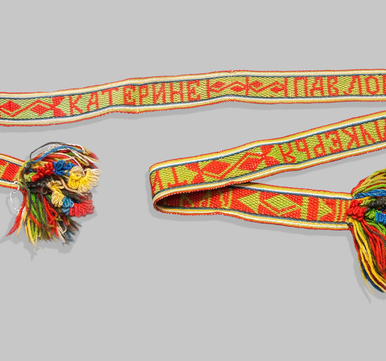Men’s trousers made of nettle cloth were transferred to the Tobolsk Provincial Museum in 1897. Their national Khanty name is khantin-ligan. The trousers were sewn by a Khanty craftswoman around the second half of the 19th century. An additional piece of fabric is sewn between the embroidered legs. They were worn by attaching a special threaded ribbon or lace to the belt. These trousers are a sample of Khanty’s home nettle weaving.
Nettle weaving is a craft that was of great importance in the culture of the Northern peoples of Western Siberia. Nettle yarn was softer than linen, since it was made not from leaves, but from hollow stems. Because of this, it had a higher thermal conductivity. It was cooler in summer and warmer in winter. Nettle yarn was much cheaper than linen, since it was possible to collect nettles at any time of the year.
By the beginning of the 20th century, it was undeservedly forgotten, as inexpensive various fabrics of factory production appeared in large quantities. Today, the Tobolsk Museum-Reserve keeps a collection of nettle clothing collected during ethnographic expeditions in 1910-1911, as well as looms, spindles, and tools for processing nettles.
The pattern on the fabric of the Khanty men’s trousers clearly shows a geometric pattern, and special attention is drawn to the solar symbol, or swastika. Solar symbol is the symbol to represent the sun symbolizing light and warmth. The swastika is one of the oldest and most widely used graphic symbols. In many peoples of the world, it is depicted on everyday objects, clothing, coins, vases, weapons, banners, and coats of arms. This symbol dates back to the 8th Millennium BC. Presumably, it originated from a diamond -meander ornament that first appeared in the Late Paleolithic.
The solar sign is a cross, each of the four ends of which is bent at a right angle. The angles are directed to one of the sides, i.e. to the right or to the left, and this creates the feeling of its rotation. The direction of rotation of the swastika can be left-hand or counterclockwise, and right-hand or clockwise. Sometimes a swastika with a left-hand rotation is called ‘sauwastika’. The swastika as a symbol has many meanings. Among the ancient peoples, it was a symbol of movement, life, sun, light, and well-being. Solar symbols of the Slavs were often used as amulets. In the 20th century, the swastika became known as a symbol of Nazism and Hitler’s Germany, and became steadily associated with the regime of the Nazi dictatorship and ideology.
Nettle weaving is a craft that was of great importance in the culture of the Northern peoples of Western Siberia. Nettle yarn was softer than linen, since it was made not from leaves, but from hollow stems. Because of this, it had a higher thermal conductivity. It was cooler in summer and warmer in winter. Nettle yarn was much cheaper than linen, since it was possible to collect nettles at any time of the year.
By the beginning of the 20th century, it was undeservedly forgotten, as inexpensive various fabrics of factory production appeared in large quantities. Today, the Tobolsk Museum-Reserve keeps a collection of nettle clothing collected during ethnographic expeditions in 1910-1911, as well as looms, spindles, and tools for processing nettles.
The pattern on the fabric of the Khanty men’s trousers clearly shows a geometric pattern, and special attention is drawn to the solar symbol, or swastika. Solar symbol is the symbol to represent the sun symbolizing light and warmth. The swastika is one of the oldest and most widely used graphic symbols. In many peoples of the world, it is depicted on everyday objects, clothing, coins, vases, weapons, banners, and coats of arms. This symbol dates back to the 8th Millennium BC. Presumably, it originated from a diamond -meander ornament that first appeared in the Late Paleolithic.
The solar sign is a cross, each of the four ends of which is bent at a right angle. The angles are directed to one of the sides, i.e. to the right or to the left, and this creates the feeling of its rotation. The direction of rotation of the swastika can be left-hand or counterclockwise, and right-hand or clockwise. Sometimes a swastika with a left-hand rotation is called ‘sauwastika’. The swastika as a symbol has many meanings. Among the ancient peoples, it was a symbol of movement, life, sun, light, and well-being. Solar symbols of the Slavs were often used as amulets. In the 20th century, the swastika became known as a symbol of Nazism and Hitler’s Germany, and became steadily associated with the regime of the Nazi dictatorship and ideology.

